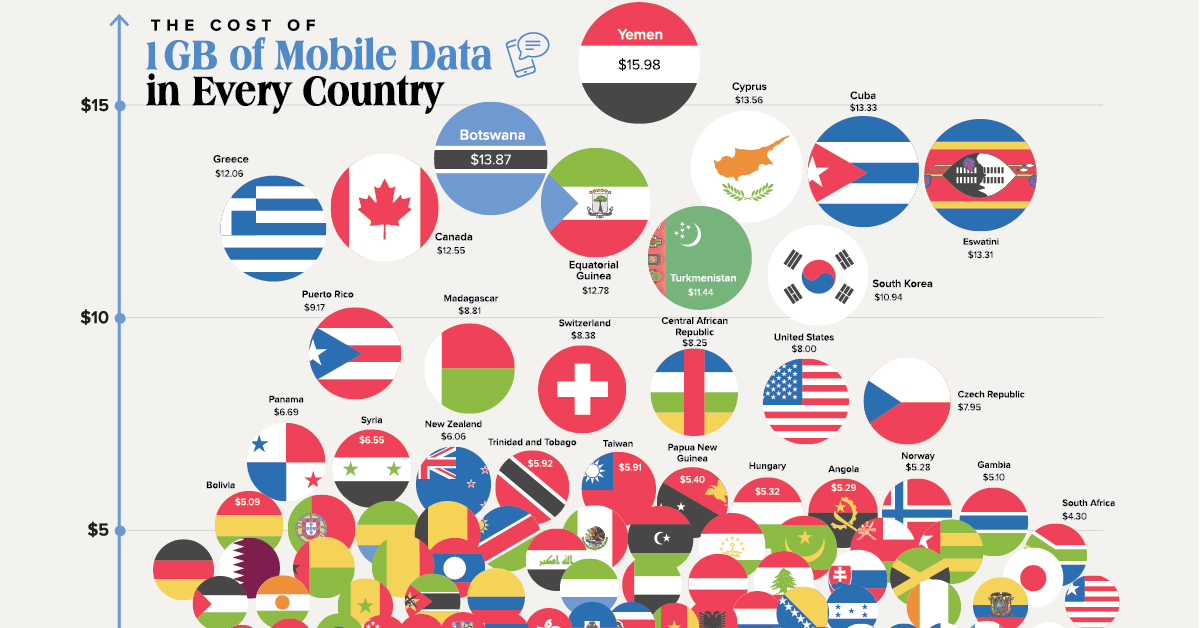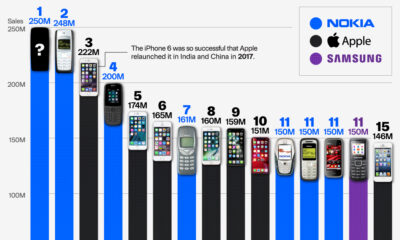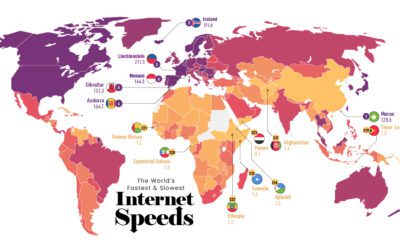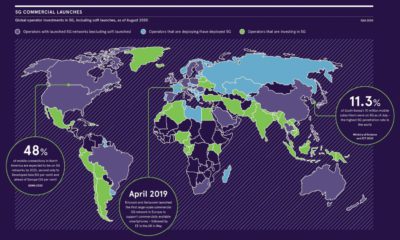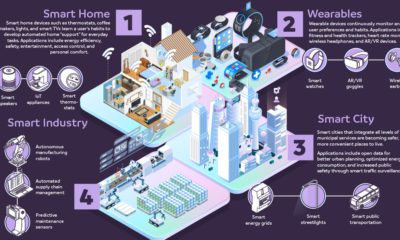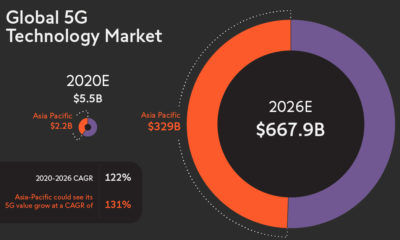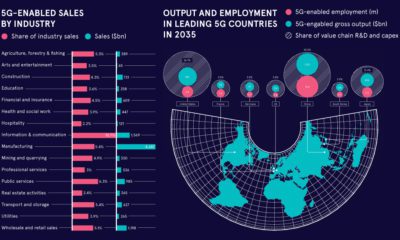Technology
What Does 1GB of Mobile Data Cost in Every Country?
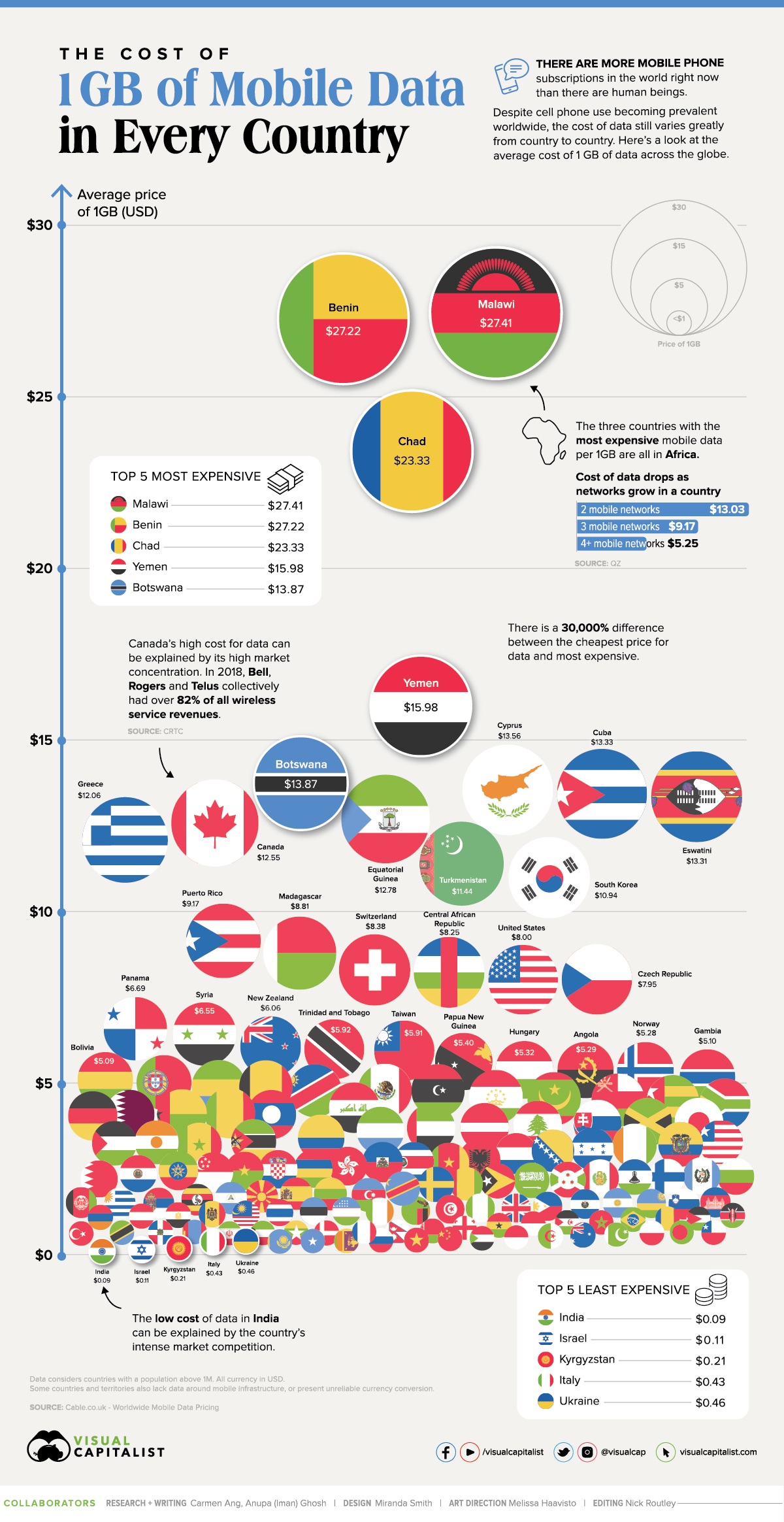
What Does 1GB of Mobile Data Cost in Every Country?
Billions of people around the world rely on their mobile phones every day.
Even in a saturated market, mobile networks have continued to expand their reach. In the last five years alone, almost one billion additional people have gained access to mobile data services.
Despite the growing prevalence of these networks worldwide, the cost of gaining access can vary greatly from country to country—particularly when it comes to the price of mobile data.
Today’s chart uses figures from Cable.co.uk to showcase the average cost of one gigabyte (GB) of mobile data in 155 different countries and jurisdictions. Despite the vast global reach of the mobile economy, it’s clear it still has a long way to go to reach true accessibility.
Discrepancies in Mobile Data Costs
Researchers have identified several key elements that help explain the cost variation for mobile data between countries:
- Existing infrastructure (or lack thereof): This might seem counterintuitive, but most mobile networks rely on a fixed-line connection. As a result, countries with existing infrastructure are able to offer mobile plans with more data, at a cheaper price. This is the case for India and Italy. Countries with minimal or no infrastructure rely on more costly connection alternatives like satellites, and the cost typically gets passed down to the consumer.
- Reliance on mobile data: When mobile data is the primary source of internet in a particular region, adoption can become nearly universal. This high demand typically leads to an increase in competing providers, which in turn lowers the cost. Kyrgyzstan is a good example of this.
- Low data consumption: Countries with poor infrastructure tend to use less data. With mobile plans that offer smaller data limits, the overall average cost per GB tends to skew higher. Countries like Malawi and Benin are examples of this phenomenon.
- Average income of consumer: Relatively wealthy nations tend to charge more for mobile services since the population can generally afford to pay more, and the cost of operating a network is higher. This is apparent in countries like Canada or Germany.
The Cheapest Countries for 1 GB of Data
Even among the cheapest countries for mobile data, the cost variation is significant. Here’s a look at the top five cheapest countries for 1 GB of data:
| Overall Rank | Country | Average price of 1GB (USD) |
|---|---|---|
| 1 | 🇮🇳 India | 9¢ |
| 2 | 🇮🇱 Israel | 11¢ |
| 3 | 🇰🇬 Kyrgyzstan | 21¢ |
| 4 | 🇮🇹 Italy | 43¢ |
| 5 | 🇺🇦 Ukraine | 46¢ |
India ranks the cheapest at $0.09 per GB, a 65% decrease in price compared to the country’s average cost in 2019.
Why is data so cheap in India? A significant factor is the country’s intense market competition, driven by Reliance Jio—a telecom company owned by Reliance Industries, one of the largest conglomerates in India. Reliance Jio launched in 2016, offering customers free trial periods and plans for less than a $1 a month. This forced other providers to drop their pricing, driving down the overall cost of data in the region.
Because these prices are likely unsustainable for the long term, India’s cheaper-than-usual prices may soon come to an end.
Another country worth highlighting is Kyrgyzstan, which ranks as the third cheapest at $0.21 per GB, ahead of Italy and Ukraine. This ranking is surprising, given the country’s minimal fixed-line infrastructure and large rural population. Researchers suspect the low cost is a result of Kyrgyzstan’s heavy reliance on mobile data as the population’s primary source of internet.
The Most Expensive Countries for 1 GB of Data
On the other end of the spectrum, here are the top five most expensive countries for one gigabyte of mobile data:
| Overall Rank | Country | Average price of 1GB (USD) |
|---|---|---|
| 155 | 🇲🇼 Malawi | $27.41 |
| 154 | 🇧🇯 Benin | $27.22 |
| 153 | 🇹🇩 Chad | $23.33 |
| 152 | 🇾🇪 Yemen | $15.98 |
| 151 | 🇧🇼 Botswana | $13.87 |
A striking trend worth noting is that four out of five of the most expensive countries for mobile data are in Sub-Saharan Africa (SSA).
A significant factor behind the high cost of data in SSA is its lack of infrastructure. With overburdened networks, the data bundles offered in the region are generally smaller. This drives up the average cost per GB when compared to countries with unlimited packages.
Another element that contributes to SSA’s high costs is its lack of market competition. In countries with multiple competing networks, such as Nigeria, the cost of data skews lower.
The Full Breakdown
The below table has a full list of all 155 countries and jurisdictions included in the data set. It helps demonstrate the stark contrast in the cost of mobile data between the most expensive and cheapest countries globally.
| Rank | Country | Average price of 1GB (USD) |
|---|---|---|
| 1 | India | 9¢ |
| 2 | Israel | 11¢ |
| 3 | Kyrgyzstan | 21¢ |
| 4 | Italy | 43¢ |
| 5 | Ukraine | 46¢ |
| 6 | Kazakhstan | 46¢ |
| 7 | Somalia | 50¢ |
| 8 | Sri Lanka | 51¢ |
| 9 | Russian Federation | 52¢ |
| 10 | Vietnam | 57¢ |
| 11 | China | 61¢ |
| 12 | Sudan | 63¢ |
| 13 | Indonesia | 64¢ |
| 14 | Algeria | 65¢ |
| 15 | Australia | 68¢ |
| 16 | Pakistan | 69¢ |
| 17 | Poland | 70¢ |
| 18 | Bangladesh | 70¢ |
| 19 | Chile | 71¢ |
| 20 | Turkey | 72¢ |
| 21 | Tanzania | 73¢ |
| 22 | Dominican Republic | 74¢ |
| 23 | Mongolia | 74¢ |
| 24 | Iran | 75¢ |
| 25 | Kuwait | 77¢ |
| 26 | Myanmar | 78¢ |
| 27 | Denmark | 80¢ |
| 28 | France | 81¢ |
| 29 | Nepal | 86¢ |
| 30 | Belarus | 89¢ |
| 31 | Georgia | 93¢ |
| 32 | Ghana | 94¢ |
| 33 | Monaco | 98¢ |
| 34 | Western Sahara | 99¢ |
| 35 | Morocco | 99¢ |
| 36 | Brazil | $1.01 |
| 37 | Romania | $1.03 |
| 38 | Jordan | $1.03 |
| 39 | Kenya | $1.05 |
| 40 | Armenia | $1.05 |
| 41 | Austria | $1.08 |
| 42 | Egypt | $1.09 |
| 43 | Moldova | $1.12 |
| 44 | Malaysia | $1.12 |
| 45 | Thailand | $1.23 |
| 46 | Estonia | $1.27 |
| 47 | Uzbekistan | $1.34 |
| 48 | Ireland | $1.36 |
| 49 | Zambia | $1.36 |
| 50 | Tunisia | $1.37 |
| 51 | Nigeria | $1.39 |
| 52 | United Kingdom | $1.39 |
| 53 | Philippines | $1.42 |
| 54 | El Salvador | $1.45 |
| 55 | Argentina | $1.45 |
| 56 | Rwanda | $1.48 |
| 57 | Slovenia | $1.48 |
| 58 | Cambodia | $1.50 |
| 59 | Afghanistan | $1.55 |
| 60 | Uruguay | $1.58 |
| 61 | Serbia | $1.60 |
| 62 | Uganda | $1.62 |
| 63 | Nicaragua | $1.71 |
| 64 | Macedonia | $1.75 |
| 65 | Spain | $1.81 |
| 66 | Lithuania | $1.85 |
| 67 | Azerbaijan | $1.86 |
| 68 | Congo | $1.94 |
| 69 | Sweden | $2.07 |
| 70 | Guinea | $2.08 |
| 71 | Timor-Leste | $2.08 |
| 72 | Saudi Arabia | $2.12 |
| 73 | Burundi | $2.12 |
| 74 | Peru | $2.13 |
| 75 | Lesotho | $2.13 |
| 76 | Finland | $2.14 |
| 77 | Guatemala | $2.17 |
| 78 | Bulgaria | $2.22 |
| 79 | Bahrain | $2.27 |
| 80 | Paraguay | $2.30 |
| 81 | Ethiopia | $2.44 |
| 82 | Singapore | $2.47 |
| 83 | Burkina Faso | $2.47 |
| 84 | Croatia | $2.48 |
| 85 | Mauritius | $2.48 |
| 86 | Hong Kong | $2.55 |
| 87 | Haiti | $2.74 |
| 88 | Costa Rica | $2.74 |
| 89 | Cameroon | $2.75 |
| 90 | Albania | $2.83 |
| 91 | Netherlands | $2.98 |
| 92 | Bosnia and Herzegovina | $3.04 |
| 93 | Honduras | $3.12 |
| 94 | Côte d'Ivoire | $3.20 |
| 95 | Ecuador | $3.24 |
| 96 | Liberia | $3.25 |
| 97 | Palestine | $3.26 |
| 98 | Niger | $3.30 |
| 99 | Senegal | $3.30 |
| 100 | Mozambique | $3.33 |
| 101 | Colombia | $3.46 |
| 102 | Sierra Leone | $3.69 |
| 103 | United Arab Emirates | $3.78 |
| 104 | Latvia | $3.79 |
| 105 | Lebanon | $3.82 |
| 106 | Slovakia | $3.84 |
| 107 | Jamaica | $3.88 |
| 108 | Japan | $3.91 |
| 109 | Germany | $4.06 |
| 110 | Qatar | $4.12 |
| 111 | Guinea-Bissau | $4.12 |
| 112 | Mali | $4.12 |
| 113 | Lao PDR | $4.16 |
| 114 | Iraq | $4.20 |
| 115 | South Africa | $4.30 |
| 116 | Togo | $4.50 |
| 117 | Oman | $4.58 |
| 118 | Mauritania | $4.63 |
| 119 | Tajikistan | $4.65 |
| 120 | Libya | $4.73 |
| 121 | Mexico | $4.77 |
| 122 | Namibia | $4.78 |
| 123 | Belgium | $4.88 |
| 124 | Gabon | $4.89 |
| 125 | Portugal | $4.97 |
| 126 | Bolivia | $5.09 |
| 127 | Gambia | $5.10 |
| 128 | Norway | $5.28 |
| 129 | Angola | $5.29 |
| 130 | Hungary | $5.32 |
| 131 | Papua New Guinea | $5.40 |
| 132 | Taiwan | $5.91 |
| 133 | Trinidad and Tobago | $5.92 |
| 134 | New Zealand | $6.06 |
| 135 | Syria | $6.55 |
| 136 | Panama | $6.69 |
| 137 | Czech Republic | $7.95 |
| 138 | United States | $8.00 |
| 139 | Central African Republic | $8.25 |
| 140 | Switzerland | $8.38 |
| 141 | Madagascar | $8.81 |
| 142 | Puerto Rico | $9.17 |
| 143 | South Korea | $10.94 |
| 144 | Turkmenistan | $11.44 |
| 145 | Greece | $12.06 |
| 146 | Canada | $12.55 |
| 147 | Equatorial Guinea | $12.78 |
| 148 | Eswatini | $13.31 |
| 149 | Cuba | $13.33 |
| 150 | Cyprus | $13.56 |
| 151 | Botswana | $13.87 |
| 152 | Yemen | $15.98 |
| 153 | Chad | $23.33 |
| 154 | Benin | $27.22 |
| 155 | Malawi | $27.41 |
Interestingly, the highest average cost is 30,000% more than the cheapest average price.
The Technology Gap
Will we reach a point of equal accessibility across the globe, or will the technology gap between countries continue to widen?
With 5G networks on the rise, just seven countries are expected to make up the majority of 5G related investments. Time will tell what this means for adoption worldwide.
Editor’s Note: The methodology used by Cable.co.uk represents a region’s national average, based on both pre-paid and post-paid plans. While the data correctly represents each region’s average cost on 1 GB based on the chosen methodology, Cable.co.uk acknowledges that it may not reflect the way most people in a country consume data.
Brands
How Tech Logos Have Evolved Over Time
From complete overhauls to more subtle tweaks, these tech logos have had quite a journey. Featuring: Google, Apple, and more.

How Tech Logos Have Evolved Over Time
This was originally posted on our Voronoi app. Download the app for free on iOS or Android and discover incredible data-driven charts from a variety of trusted sources.
One would be hard-pressed to find a company that has never changed its logo. Granted, some brands—like Rolex, IBM, and Coca-Cola—tend to just have more minimalistic updates. But other companies undergo an entire identity change, thus necessitating a full overhaul.
In this graphic, we visualized the evolution of prominent tech companies’ logos over time. All of these brands ranked highly in a Q1 2024 YouGov study of America’s most famous tech brands. The logo changes are sourced from 1000logos.net.
How Many Times Has Google Changed Its Logo?
Google and Facebook share a 98% fame rating according to YouGov. But while Facebook’s rise was captured in The Social Network (2010), Google’s history tends to be a little less lionized in popular culture.
For example, Google was initially called “Backrub” because it analyzed “back links” to understand how important a website was. Since its founding, Google has undergone eight logo changes, finally settling on its current one in 2015.
| Company | Number of Logo Changes |
|---|---|
| 8 | |
| HP | 8 |
| Amazon | 6 |
| Microsoft | 6 |
| Samsung | 6 |
| Apple | 5* |
Note: *Includes color changes. Source: 1000Logos.net
Another fun origin story is Microsoft, which started off as Traf-O-Data, a traffic counter reading company that generated reports for traffic engineers. By 1975, the company was renamed. But it wasn’t until 2012 that Microsoft put the iconic Windows logo—still the most popular desktop operating system—alongside its name.
And then there’s Samsung, which started as a grocery trading store in 1938. Its pivot to electronics started in the 1970s with black and white television sets. For 55 years, the company kept some form of stars from its first logo, until 1993, when the iconic encircled blue Samsung logo debuted.
Finally, Apple’s first logo in 1976 featured Isaac Newton reading under a tree—moments before an apple fell on his head. Two years later, the iconic bitten apple logo would be designed at Steve Jobs’ behest, and it would take another two decades for it to go monochrome.
-

 Travel1 week ago
Travel1 week agoAirline Incidents: How Do Boeing and Airbus Compare?
-

 Markets3 weeks ago
Markets3 weeks agoVisualizing America’s Shortage of Affordable Homes
-

 Green2 weeks ago
Green2 weeks agoRanked: Top Countries by Total Forest Loss Since 2001
-

 Money2 weeks ago
Money2 weeks agoWhere Does One U.S. Tax Dollar Go?
-

 Misc2 weeks ago
Misc2 weeks agoAlmost Every EV Stock is Down After Q1 2024
-

 AI2 weeks ago
AI2 weeks agoThe Stock Performance of U.S. Chipmakers So Far in 2024
-

 Markets2 weeks ago
Markets2 weeks agoCharted: Big Four Market Share by S&P 500 Audits
-

 Real Estate2 weeks ago
Real Estate2 weeks agoRanked: The Most Valuable Housing Markets in America




